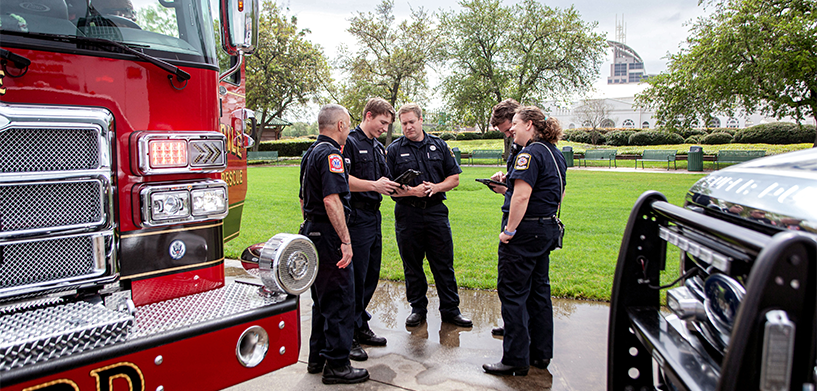Public safety agencies are undergoing a process of modernization and are challenged to digitally transform operations. There’s a lot of high-level talk in the marketplace about the specifics of digital transformation and the capabilities agencies need to achieve it.
What do agencies need to make this happen? What do they want? We spoke with Hexagon experts around the world to find out, and we’ll be sharing their perspectives in a series of blog posts.
Here’s what John Whitehead had to say about public safety agencies in North America.
Wendy Sack: How do you define digital transformation when it comes to public safety agencies, and what kinds of challenges do these agencies face as a result of this transformation?
John Whitehead: Digital transformation in public safety is simply taking data and utilizing it to respond quicker, be more knowledgeable in the response, and, ultimately, be safer when handling incidents. That, to me, is digital transformation.
Historically, there’s always a few personnel, or that one person at an agency who seems to have been there forever who knows everything, knows every cross street, every person in the community. Those people retire or decide to leave, and then new people coming in don’t have that knowledge or history. Utilizing tools such as artificial intelligence (AI) to provide responders and dispatchers with historical data is an advantage of digital transformation. It’s getting that knowledge to their fingertips when they need it.
The challenges here are twofold. One, they must have the technology to provide this data as needed. No one has time to dig through historical data and sort it out. The second is acceptance and getting over the “We’ve always done it this way” mindset. Agencies will say they have a workflow in place, “We give the officer the incident information, the officer responds, and when needed, a second car or officer responds. We’ve always done it that way.” It’s the acceptance of the digital transformation, the acceptance that, “Hey, there is some knowledge there that an AI-type of application can provide me.” That is a challenge that we see in public safety – the trust factor in the technology.
WS: Is it fair to say that modernization can be challenging because many public safety agencies have relied on legacy technology for quite some time? Plus, investments in new technology can take more time?
JW: It’s fair to say we’ve relied on legacy technology for quite some time. To this day, you’ll see agencies that put an RFP out, and they focus entirely on today’s workflow, meaning the workflow they’ve been doing in their legacy technology. And yes, there are new things in there, but when we go in, and we talk about workflows, they’ll still say, “This is the way we do things, and this system needs to meet that.” I think that is a challenge. There’s a saying: Don’t spend a million dollars on a new system only to make it look, feel and act like the system that you’re trying to replace.
I think some of the more progressive agencies are looking at the benefits. They see the big picture and understand they are investing in new technology to save time and money. The new technology provides the tools to be more efficient and safer, saving money by enhancing responses, eliminating additional equipment, and sending the proper equipment and resources to the incident. It becomes an investment, where spending the money upfront could save you long term.
WS: What other considerations make modernization difficult for public safety agencies?
JW: Other considerations that make modernization difficult for public safety agencies include the human element, that is, we are creatures of habit. I remember years ago, officers telling me, “Mobile is going to waste my time in my car. I have my pad of paper, my pencil, and what my dispatcher tells me, I write it down and respond. I know my territory, and I don’t know why I need this mobile.” I remember thinking that it would be difficult because you’ve got these people who have been around for a long time. They know their job and say, “This technology should not get in my way.”
It takes a little bit of time. There’s enormous fear and uncertainty there when it comes to modernization, and, especially in public safety, we go with what works. We go back to what’s comfortable, we know what works, we’ve done it this way for years and it’s a proven method. I think that’s probably the tricky thing regarding modernization. As vendors and agencies, we must work together on the change management aspect to let people know the newer technology. The digital transformation will be an aid to them and not a hindrance.
WS: As more and more data is available as a result of digital transformation, agencies are facing increasing requirements for transparency and more accountability in their communities. How does this impact the daily work of these agencies? What are the advantages and disadvantages?
JW: I think it raises the bar on professionalism. Everywhere we go, we’re on video; every action we take, we’re on video. I think that impacts agencies, in the long term, very positively, but in the short term, it also gives everybody the ability to Monday morning quarterback every reaction and action. We see body camera footage, and we can slow it down and watch it in high definition, but the officers are out there reacting in a split second, making split-second decisions. I think that’s a challenge right now that a lot of public safety agencies are trying to deal with. “I’ve got a split second to react. I did it using my training, but now someone can sit back and rewatch the video or slow that video down or analyze that video and zoom in and get the details that I may not have had in that split second.”
A big advantage of transparency relates to budgets and funding requests. Supplying data and reports lets the community know how many calls an agency had in a year, the response times and how these numbers compare year over year. That can help when it’s time to look at budgets. The advantage of digital transformation and the transparency aspect ensures the public becomes more in tune with the difficulties and workload agencies are handling. I think empathy then comes into play from the public when they see just how busy these agencies are. They understand a little bit more, and because they understand, they’re a little more accepting when an agency asks them to vote for a tax hike or bond issue.
WS: What are the biggest wants and needs of today’s public safety providers?
JW: I hear most from public safety providers that they are spending a lot of money, and when they need assistance with their technology, they’re not getting it from their vendor. I think the most significant want and need today is the customer experience. These agencies are professional police, fire, EMS and dispatch. That’s what they do. They need a vendor that will take care of them when it comes to the technologies, so they don’t have to worry about the technology on a day-to-day basis. They need to know that they’re covered when – and it’s not if, it’s when – the technology has an issue. They need to know they can pick up the phone and call someone, and the vendor will be responsive.
WS: If you had to pick one thing you think these agencies would want from their digital transformation/modernization journeys, what would it be and why?
JW: I’m going to go with the change management aspect. Again, features and functionality can be added and changed easily. We can do anything we want with technology in today’s world. So, when it comes to features and functionality, all that is time and money. I think what agencies are wanting and expecting from their digital transformation/modernization journey is a vendor that’s going to be able to support them throughout the journey. They want to know that we’ve got their back and that we are here to assist them. We’re going to be there with you as a partner and walk with you through this journey to make sure your system is configured, designed, and set up to meet the needs of your specific agency.
Let’s do this together.
Want to learn about Hexagon’s public safety solutions? Contact us today!

John Whitehead, vice president of sales, North America public safety for Hexagon’s Safety, Infrastructure & Geospatial division, is based in St. Louis, Missouri.















